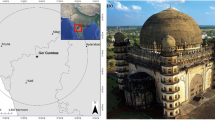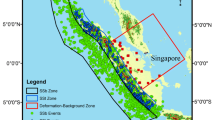Abstract
A probabilistic seismic hazard analysis (PSHA) was conducted to establish the hazard spectra for a site located at Dubai Creek on the west coast of the United Arab Emirates (UAE). The PSHA considered all the seismogenic sources that affect the site, including plate boundaries such as the Makran subduction zone, the Zagros fold-thrust region and the transition fault system between them; and local crustal faults in UAE. PSHA indicated that local faults dominate the hazard. The peak ground acceleration (PGA) for the 475-year return period spectrum is 0.17 g and 0.33 g for the 2,475-year return period spectrum. The hazard spectra are then employed to establish rock ground motions using the spectral matching technique.
Similar content being viewed by others
References
Abdalla JA and AL-Homoud AS (2004), “Seismic Hazard Assessment of United Arab Emirates and Its Surroundings,” Journal of Earthquake Engineering, 8(6): 817–837.
Abrahamson NA and Silva WJ (1997), “Empirical Response Spectral Attenuation Relations for Shallow Crustal Earthquakes,” Seismological Research Letters, 68(1): 94–127.
Ambraseys NN Simpson KA and Bommer JJ (1996), “Prediction of Horizontal Response Spectra in Europe,” Earthquake Engineering and Structural Dynamics, 25: 371–400.
Berberian M (1995), “Master “Blind” Thrust Faults Hidden Under the Zagros Folds: Active Basement Tectonics and Surface Morphotectonics,” Tectonophysics, 241: 193–224.
Boore DM, Joyner WB, Joyner and TE Fumal (1997), “Equations for Estimating Horizontal Response Spectra and Peak Acceleration from Western North American Earthquakes: A Summary of Recent Work,” Seismological Research Letters, 68(1): 128–153.
Byrne DE, Sykes LR and Davies DM (1992), “Great Thrust Earthquakes and Seismic Slip Along the Plate Boundary of the Makran Subduction Zone,” Journal of Geophysical Research, 97: 449–478.
Campbell KW (2003), “Prediction of Strong Ground Motion Using the Hybrid Empirical Method and Its Use in the Development of Ground-motion (Attenuation) Relations in Eastern North America,” Bulletin Seismological Society of America, 93(3): 1012–1033.
Campbell KW and Y Bozorgnia (2003), “Updated Near-source Ground Motion (Attenuation) Relations for the Horizontal and Vertical Components of PGA and Acceleration Response Spectra,” Bulletin Seismological Society of America, 93(1): 314–331.
Coppersmith KJ and Youngs RR (1986), “Capturing Uncertainty in Probabilistic Seismic Hazard Assessments with Intraplate Tectonic Environments,” Proceedings, 3rd U.S. National Conference on Earthquake Engineering, Charleston, South Carolina, pp. 301–312.
Cornell CA (1968), “Engineering Seismic Risk Analysis,” Bulletin of Seismological Society of America, 58(5): 1583–1606.
DeMets C, Gordon RG, Argus DF and Stein S (1990), “Current Plate Motions,” Geophysical Journal International, 101: 425–478.
EZ-FRISK-7.26, (2008), A Program for Earthquake Ground Motion Estimation, Risk Engineering Inc, Boulder, CO USA.
Farshad J, Fatemi SM and Aliyari A (2006), “Evaluation of Seismic Sources for Hazard Assessment in the Fujairah Emirate (UAE),” Proceedings of the 10th International Association for Engineering Geology and Environment Congress, Nottingham, UK, pp. 305.
Gregor NJ, Silva WJ, Wong IG and Youngs RR (2002), “Ground-motion Attenuation Relationships for Cascadia Subduction Zone Megathrust Earthquakes Based on a Stochastic Finite-fault Model,” Bulletin of the Seismological Society of America, 92(5): 1923–1932.
IIEES (2008), International Institute of Earthquake Engineering and Seismology, http://www.iiees.ac.ir
IRIS (2008), Incorporated Research Institutions for Seismology, Washington, DC http://www.iris.edu.
Johnson PR (1998), “Tectonic Map of Saudi Arabia and Adjacent Areas,” Deputy Ministry for Mineral Resources Technical Report USGS-tr-98-3 (IR-948).
Kusky T, Robinson C and El-Baz F (2005), “Tertiaryquaternary Faulting and Uplift in Northern Oman Hajar Mountains,” Journal of the Geological Society, 162: 871–888.
McGuire RK (2004), “Seismic Hazard and Risk Analysis,” EERI Monograph MNO-10.
McGuire RK and Arabasz WJ (1990), “An Introduction to Probabilistic Seismic Hazard Analysis,” Geotechnical and Environmental Geophysics, Volume 1.
Mwafy A, El Nashai A, Sigbjornsson R and Salama A, (2006), “Significance of Severe Distant and Moderate Close Earthquakes on Design and Behavior of Tall Buildings,” Structural Design of Tall Buildings, 15: 391–416.
Regard V, Bellier O, Thomas J, Bourles and Feghhi K (2005), “Cumulative Right-lateral Fault Slip Rate Across the Zagros-makran Transfer Zone: Role of the Minab-zendan Fault System in Accommodating Arabiaeurasia Convergence in Southeast Iran,” Geophysical Journal International, 162: 177–203.
Rodgers A, Fowler A, Al-Amri A and Al-Enezi A (2006), “The March 11, 2002 Masafi, United Arab Emirates Earthquake: Insights into the Seismotectonics of the Northern Oman Mountains,” Tectonophysics, 414: 57–64.
Silva WJ and Lee K (1987) “State-of-the-art for Assessing Earthquake Hazards in the U.S.,” Report 24-S-73. U.S. Army Engineers Waterways Experiment Station. Vicksburg, MS.
Tavakoli B and Ashtiany MG (1999), “Seismic Hazard Assessment of Iran,” Annali Di Geofisica, 42(6): 1013–1021.
Wells DL and Coppersmith KJ (1994), “New Empirical Relationships Among Magnitude, Rupture Length, Rupture Width, Rupture Area, and Surface Displacement,” Bull. Seis. Soc. Am., 84(4): 974–1002.
Wyss M and Al-Homoud A (2004), “Scenarios of Seismic Risk in the United Arab Emirates, an Approximate Estimate,” Natural Hazards, 32:375–393
Youngs RR, Chiou SJ, Silva WJ and Humphrey JR (1997), “Strong Ground Motion Attenuation Relationships for Subduction Zone Earthquakes,” Seismological Research Letters, 68(1): 58–73.
Vernant P et al. (2004), “Present-day Crustal Deformation and Plate Kinematics in the Middle East Constrained by GPS Measurements in Iran and Northern Oman,” Geophysical Journal, 157: 381–398.
Ziegler M (2001), “Late Permian to Holocene Paleofacies Evolution of the Arabian Plate and Its Hydrocarbon Occurrences,” GeoArabia, 6(3).
Author information
Authors and Affiliations
Corresponding author
Rights and permissions
About this article
Cite this article
Shama, A.A. Site specific probabilistic seismic hazard analysis at Dubai Creek on the west coast of UAE. Earthq. Eng. Eng. Vib. 10, 143–152 (2011). https://doi.org/10.1007/s11803-011-0053-5
Received:
Accepted:
Published:
Issue Date:
DOI: https://doi.org/10.1007/s11803-011-0053-5




